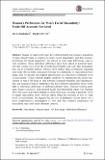Files in this item
Women’s preferences for men’s facial masculinity : trade-off accounts revisited
Item metadata
| dc.contributor.author | Holzleitner, Iris J. | |
| dc.contributor.author | Perrett, David I. | |
| dc.date.accessioned | 2017-08-14T11:30:08Z | |
| dc.date.available | 2017-08-14T11:30:08Z | |
| dc.date.issued | 2017-12 | |
| dc.identifier | 250289821 | |
| dc.identifier | 5b61917a-7f0a-444d-af35-d7f6b01f3c61 | |
| dc.identifier | 85034418275 | |
| dc.identifier | 000413629900004 | |
| dc.identifier.citation | Holzleitner , I J & Perrett , D I 2017 , ' Women’s preferences for men’s facial masculinity : trade-off accounts revisited ' , Adaptive Human Behavior and Physiology , vol. 3 , no. 4 , pp. 304-320 . https://doi.org/10.1007/s40750-017-0070-3 | en |
| dc.identifier.issn | 2198-7335 | |
| dc.identifier.other | ORCID: /0000-0002-6025-0939/work/64360910 | |
| dc.identifier.uri | https://hdl.handle.net/10023/11441 | |
| dc.description.abstract | Studies on mate preferences have demonstrated that women’s perception of male attractiveness is sensitive to men’s facial masculinity, and that women’s preferences for facial masculinity are subject to individual differences, such as own condition. These individual differences have been linked to potential trade-offs that women face given the hypothesized benefits and costs that masculinity may cue in a potential partner. Whereas most studies based conclusions regarding such trade-offs on shifts in mean preferences for a feminized vs. masculinized face shape, here we directly investigated attractiveness as a function of different levels of masculinity. Using computer-graphic methods, we manipulated the facial masculinity of men’s 3D faces to vary between extremely feminine and hypermasculine, and assessed women’s preferences for these different masculinity levels in the light of individual differences in self-rated attractiveness, financial worries, pathogen disgust sensitivity, self-reported health and relationship status. Our findings show that some individual differences shift preferences towards a generally lower or higher masculinity level, whereas others affect the tolerance to low vs. high levels of masculinity. We suggest that the use of preference curves allows for a more comprehensive investigation of how and why women’s preferences for masculinity may shift under different contexts. | |
| dc.format.extent | 654146 | |
| dc.language.iso | eng | |
| dc.relation.ispartof | Adaptive Human Behavior and Physiology | en |
| dc.subject | Masculinity | en |
| dc.subject | Attractiveness | en |
| dc.subject | 3D | en |
| dc.subject | Face shape | en |
| dc.subject | Individual differences | en |
| dc.subject | BF Psychology | en |
| dc.subject | DAS | en |
| dc.subject.lcc | BF | en |
| dc.title | Women’s preferences for men’s facial masculinity : trade-off accounts revisited | en |
| dc.type | Journal article | en |
| dc.contributor.institution | University of St Andrews. School of Psychology and Neuroscience | en |
| dc.contributor.institution | University of St Andrews. Institute of Behavioural and Neural Sciences | en |
| dc.contributor.institution | University of St Andrews. Centre for Social Learning & Cognitive Evolution | en |
| dc.identifier.doi | 10.1007/s40750-017-0070-3 | |
| dc.description.status | Peer reviewed | en |
| dc.identifier.url | https://link.springer.com/article/10.1007%2Fs40750-017-0070-3#SupplementaryMaterial | en |
This item appears in the following Collection(s)
Items in the St Andrews Research Repository are protected by copyright, with all rights reserved, unless otherwise indicated.

